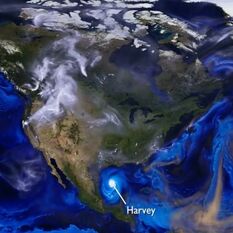 You don't have to be a journalism professor to see that national media coverage of hurricanes and wildfires are different in both style and duration. You see it most dramatically when there are a small number of active fires with large impacts happening at about the same time as a hurricane hitting the US coastline. It's even more acute when an incident like the Camp Fire is responsible for more lives lost and perhaps just as much property damage as a typical hurricane. Or the Woolsey Fire where there are deaths and 200,000 residents evacuated. People wonder why the national media is not sending their top anchors to report continuously from the fire lines like they do from the beaches during a hurricane. Of course, people know hurricanes are coming well before they hit land while wildfires may run through a community within a matter of hours. Hurricanes also happen on the Atlantic and Gulf coasts where more people live with larger cities and more airports. It's much more difficult to get a reporter and camera crew from New York City to the Bitterroot than it is to get them to Myrtle Beach. Reporters can also physically experience hurricanes, often reporting in strong winds and knee deep water. Such is not the case with wildland fires where most reporting is done from a distance.
But those considerations are little comfort to folks who are under stress or have experienced loss due to a wildfire. They are left scanning the news for information about their incident but only see continuous coverage of a storm far away. Public feelings of being slighted and ignored can influence how incident information is received and perceived. This puts a burden on PIOs to provide frequent, accurate, and when appropriate, empathetic information across a variety of platforms. When the fires are late in the season, the burden is greater because the usual places we have taught people to go, like the Sit Report and Inciweb, may no longer be available or updated regularly. It also increases the need for top-notch media relations work within the PIO organization so that the media who are present--especially the locals-- have the best opportunity to tell the story and reach those affected. We tend to become consumed by our own incidents but we have to remind ourselves to occasionally look around at the world and see if anything going on might be influencing our incident and our communities. If there is, adjust tactics and strategies appropriately. __ JIM Copyright © Jim Whittington, 2018, All rights reserved. Academic use approved with notification and attribution.
1 Comment
8/29/2019 07:23:44
Both can cause each other. They both injure the atmosphere. They contribute in global warming and it does not just cause fires, but flooding too. There really is something wrong with how this planet is run and I sometimes thing they are doing this intentionally. I think some people want a lot of others dead. I am not sure about their real reasons but it appears that they are either trying to create a balance not any of us understands or just plain greedy. We really can't tell. We need more research.
Reply
Leave a Reply. |
Occasional thoughts on incident response, crisis communications, wildland fire, and other topics.
Docendo disco, scribendo cogito. Blog DOB: 4/26/2018Copyright © Jim Whittington, 2019. Archives
August 2019
Categories
All
|
 RSS Feed
RSS Feed